JUDGING QUEENSLAND REVENUES 1866 - 1965
AT FIP WORLD EXHIBITIONS
Dave Elsmore
Part One
This is the seventh in the series of ‘Let’s Educate the Judges’ in evaluating the exhibits of the Australian States Revenue and Railway Stamps.
This paper is not a critique: it is written to help guide the judge in this fairly new field of revenue exhibiting. I offer my 40 years of knowledge in collecting Queensland Revenue stamps. This is not only my home state but my most favoured revenue collecting interest.
When constructing an Australian revenue exhibit there appears, from all states, to be a lack of usage on complete documents, and Queensland is no exception. Very little has come onto the open market in the last 20 years, and when found, the majority are cut outs clipped from documents before destruction. The exhibit must show adequate usage with the correct rates. As revenue collecting strengthens there is less to go round and I am predicting a major shortage of quality exhibition ‘pieces’. An exhibit without such ‘gems’ will struggle.
There are several references available to the judge to ‘polish up’ on, and as stated before in my previous papers, none are complete, and all need badly updating. A good start is ‘The Postage Stamps of Queensland’ by Bassett Hull 1930 which includes early revenue information. ‘The Revenue Stamps of Queensland’ by Bill Craig 1982. I have also published a monograph ‘Queensland Revenue Proofs’ 1988, which is a simple listing. This information was from actual proofs held by Government archives with many early issues missing from their collection. The Cinderella Journal of Australasia has several updates over the last 15 years. Other references available: ‘The Perkins Bacon & De La Rue Printings’ by Bassett Hull, 1932.
I spoke to one judge who had judged an Australian revenue exhibit in a recent exhibition seeking his reference source, and was told he got all his information out of “British Commonwealth Revenues” by Barefoot. This reference for a judge judging Australian States Revenues is just a basic listing and the judge should know better. The comments from this judge and his reference source was appalling and would not have done the exhibit any favours at all, and probably judged using the ‘30 points for presentation rule’. So if this said judge is reading this, please do your homework on the references available to you, and if you do not know, don’t be afraid to ask, we cannot be expected to know all there is. You have the title page for at least two months prior to an exhibition, and if you have prepared notes on an area you are about to judge, you will not have that ‘blank’ look on your face when facing the exhibitors questions at the frames after the critique.
Queensland first assented to the ‘Act’ in 1866 and it became known as ‘The Stamp Duties Act of 1866’.
Section One
Adhesive Issues: The exhibitor must show a selection of the 1866 essays, followed by plate proofs, not all values exist. First issued on 1 Nov 1866 [fig 1]. A Specimen of the 2/6d is recorded overprinted ‘CANCELLED’. Usage of the unwatermarked first issue above 1d is exceedingly rare, and should be appreciated by the judges. I can only put this down to poor paper quality along with thick paste gum causing severe rusting due to high moisture in the Queensland climate. Rusting of stamps in the Queensland climate continues to this present day. Perf 12½ x 13 is rare. Very thin paper is recorded on the 1/- and should be shown, it is available but rare in mint condition. First issue [fig 1]. Watermarked paper followed two years later, with some values deleted. This should be well explained by the exhibitor. Usage is available. Perf 12½ is rare, with 3 values recorded. Watermark reversed is also recorded.

Fig 1
First Day of Issue
In 1871 a second series brought a change in design. Three essays known, one is illustrated in Bassett Hull and another previously unrecorded essay [fig 2]. I would like to place this on record here. It is close to the issued design and I believe this is the only essay with a government imprint within the design located below “ONE PENNY” on any Australian revenue. A further essay has Queensland spelt “OUEENSLAND”. Any essay shown must be appreciated by the judges. Proofs & specimen overprints exist and would be a plus if shown, with the issued stamp printed on thin burelé security paper. Usage would be a big plus. This paper was short lived with purpose paper arriving early 1873. Perfed in two sizes perf 13 then perf 12. The perf 13 continued from the preceding issue and values above 2/- are scarce. The 20/- perf 13 on watermarked paper is exceedingly rare, with less than 10 recorded all fiscally used. This stamp is one of the rarest Qld revenues to exist, and if shown should be well rewarded. Perf 12 found also with wmk reversed. The 1/- is found in two transfers with some re-cutting done for the second transfer which has 10 sub types, this should be well explained.

Fig 2
Left essay, imprint under ONE PENNY
Right essay, “OUEENSLAND”
In 1878-79 the third series consisted of a single 1d receipt stamp. Plate proofs are recorded, with the stamp printed on two separate issues of Crown Q wmk paper, also on burelé security paper. This should be well explained. The second Crown Q wmk is rare and should be given a plus. Usage should be rewarded.
Fiscal Postals: Postage stamps from 1880-92 were interchangeable for revenue use, and revenue stamps were allowed for postal use within this time frame. A selection of these is a must. I have found the 5/- Rose 1866 no wmk among the rarest to find fiscally used on full document. I have one only on document recorded. The perf 9½x12 issues are rare on document fiscally used. A unique blk of 30 perf 9½x12 of the 2d is yet to be recorded and I wish to do so here. Previously only pairs have been the largest multiples. My studies have found the 1882 series of litho high values to 20/- [fig 3] were issued early 1880 as reported in Stamp News November 2004. [Stanley Gibbons 2006 have now changed their listing issue date to 1880] Personal research is still forthcoming.

Fig 3
Earliest Recorded Date
In January 1892 purpose revenue stamps were issued. Postally used copies shown must be dated before 1 July 1892. One recorded OHMS cover exists. The exhibitor must show proofs. This series was also included in parliamentary privilege packs, and carry a black or red “CTO” corner cancel, these are available and must be shown. Specimens are known. Usage is available but quality rather than quantity must be observed. The two different 3d values must be explained in correct order of issue and not as listed in reference works.
The fifth series [1d widow weeds] MUST be well explained. All reference listings along with SG [1893-1901] are wrong. This was first issued in December 1900 and was available only for several months. Dated usage would be a big plus if shown and should be appreciated by the judges.
In 1901 sixth series saw the introduction of KEV11. Colour trials are known and would be a big plus if shown. Two watermarks, both Crown over Q, both must be well explained, not all values are issued in both watermarks. Values to £100 are recorded with a handful of the £100 known, all rare, and if shown would be a plus. Usage is known and should reward. This issue was in use for nearly twenty years, and one would think it would be readily available, but it appears in very short supply.
The seventh series was issued in 1920 depicting George the fifth [fig 4], again issued in two watermarks, upright and sideways. Specimens are known, along with usage, again a plus if shown. The £5 shown on document is rare.

Fig 4
Proof
Early 1930 brought the eighth series issued. The numeral design saw a £10 value added, this should be shown. Proofs are known along with usage and should be rewarded if shown. The 1940’s saw a paper shortage and several values [not all] were issued on plain security underprint or backprint paper. These should be well explained by the exhibitor. Underprints are scarce.
Section Two
Impressed Issues: The Impressed issues have been poorly documented, and in much need of an update, but this leaves room for the exhibitor to show some further personal research. Issued on the same date as the adhesives in 1866 the colourless impressed dies were only available at the treasury to ‘stamp’ legal instruments. All were accompanied by a treasury date stamp. Values to £500 are known [a unique £500 exists] all appear scarce, with usage rare. This system was also used to emboss vellum with the help of blue base paper and a unique silver thread tied by Queen Victoria’s cypher in the form of a label on the rear side of the impression. This should all be well explained by the exhibitor. Ad Valorem, a single 1½% recorded. Also “DUTY PAID IN FULL”. An oval 1d & 2d exist and should be shown. A 1/- date plugged & with the word ‘BRISBANE’ in a rectangle recorded, this 1/- is rare one single copy recorded.
Two provincial colourless embossed die's are known with either the word ‘ROCKHAMPTON’ or 'TOWNSVILLE' at the base, with and without date plugs. The ‘without’ date plug carries a separate date stamp. A handful of each have been recorded.
Second series purpose stamps printed on watermarked paper were issued in 1895, from 3d to £500 and later several values were re-issued on unwatermarked paper. Incomplete die proofs of the 17/6 and £500 [fig 5] are known, a handful exist all rare. A single document exists using the £500. Usage of high values over £100 is very rare, if not unique. Thousands of the remaining sets were sold off to collectors @ 10/- per set of 63, all carrying a colourless embossed cancel. A single set of mint blks of 4 is known. A couple of values are recorded perf 12 x roulette and would be a big plus if shown. The perf/roul information is unrecorded and I would like to place this on record here. This issue is recorded used up to 1927, long after the death of Queen Victoria.

Fig 5
Unfinished Die Proof
Early 1904 the third series EDV11 was issued. This whole series appears scarce to rare. A unique £500 [fig 6] die proof exists. Colour trials of some values are known. The issued stamps are in black on coloured paper, blue on white paper and different colours on white paper, all must be correctly described by the exhibitor. Values 3d to £500 with a single unique £500 recorded. Mint copies are very rare, high value usage is exceedingly rare if not unique and if shown should be appreciated by the judges.

Fig 6
£500 Unique Die Proof
A fourth series was issued in 1920 GV, issued in two watermarks. Proofs are recorded from a few values, all scarce. Values range from 3d to £1000. The 45/- & £200-£500 [fig 7] are rare. Thin papers & Inverted watermarks are very rare and would be a plus if shown, these are yet to be recorded. Unique mint values £100-£1000 are known. Usage of high values is rare and would reward if shown.

Fig 7
Mint £500
Fifth series brings in the numerals issues issued early 1930, this series 1d-£5000 on Crown Q watermarked paper. I have a 5 frame exhibit on this one numeral issue alone so they are available. Complete proof sets are known and a single specimen set is recorded. The £5000 [fig 8] is also found on security underprinted paper, with a few lower values having security backprint. All should be shown by the exhibitor. The £400 & £5000 appear to be the rarest values and if shown should be rewarded. A unique full sheet of 6 of the £5000 is recorded. Usage is available for the lower values but usage £100 and over appear rare.

Fig 8
£5000
In all, does the exhibitor have good understanding and knowledge of the subject? and does the exhibitor demonstrate this knowledge?.
Revenues as a relatively new class lacks published information and simple sources for obtaining material. Thus original research and the problem of acquisition of unusual material is more difficult than in more traditional classes. This should be appreciated by the judges.
Write critiques to help the exhibitor further his exhibit. Straight negative critiques are unhelpful at the best of time.
I would strongly recommend to all revenue judges to reread the FIP GREX and SREV’s before attempting to evaluate a revenue exhibit and adhere to them. Exhibitors tend to increase the size of their exhibit over a period of time as material is sourced and added to frame by frame. If an exhibit has been rewritten, do not evaluate the exhibit on past showings. Evaluate the exhibit on what you see in the frames before you.
Treatment is left to the judge’s expertise with the exhibitor following the FIP SREV’s which can be found at the FIP web site here: https://www.f-i-p.ch/ The writer can be contacted at this email address: Dave
JUDGING QUEENSLAND REVENUES 1866-1965
AT FIP WORLD EXHIBITIONS
Dave Elsmore
Part Two
Queensland is blessed with some of the most exotic revenue issues of all the Australian States. Part two includes Beer Duty, Tax Instalment and the smaller duties of Queensland such as Banana Levy etc. Very little literature is available to the exhibitor. The Revenue Stamps of Queensland by Bill Craig 1982 is a good start but after 20 + years it is now in much need of an update. In 1988 I published Queensland Revenue Proofs a simplistic listing of all the proofs held by the Queensland Government Printer. This does have the plate proof printing dates, which would be invaluable to the exhibitor, published by the Cinderella & Revenue Society of Australasia. The Cinderella & Revenue quarterly Journal has many updates and is a 'must read'. An exhibitor would find possible to achieve a 5-8 frame exhibit on the following duties alone, it is important to note that an exhibit with badly torn or only half beer stamps should not be penalised.
Queensland has the largest range of revenue taxes of all the Australian States. To quote Joshua Bell the Colonial Treasurer in 1866 “The only things I have forgotten to tax are babies”.
Beer Duty Stamps: In 1885 the first mono colour issue was produced for ‘beer in kegs’. Different security back prints are recorded and should be well explained by the exhibitor all are available and should be shown. Imperf proofs are known for the 1885 issue for ‘bottled beer’ all are scarce but a selection should reward. Plain paper and with security back prints are recorded and should be explained. It is possible with this issue to work out the two mould types and if shown this should be appreciated by the judges. In 1899 the second issue ‘beer in kegs’ was issued, an essay is known [fig 1], two recorded.

Fig 1
1898 Essay for Beer in Kegs
Overprinted specimen and or cancelled remainders are available and a page of two should be rewarded, the 6/6d is known printed both sides. Remainders of this issue were surcharged in 1901 and a page of these should be well rewarded. 1899 saw the second issue ‘beer in bottles’ remainder sets known overprinted specimen and or cancelled, also found with the black courtesy cto ring prepared for inclusion into parliamentary privilege packs. With a change in the Beer Duty Act from 1901 stamps were to be placed in a cart note book and when the beer was delivered the receipt was torn out leaving half the stamp [fig 2] on the butt and half on the receipt. This issue is exceedingly rare as most of the remainders were sold off to collector’s overprinted specimen, less than 2 sheets of each value were line perfed 12 through the stamp to make separation easy.

Fig 2
½ Beer Stamps used on Cart-Notes, ½ on the delivery receipt and ½ on the butt
In Feb 02 the first Commonwealth ‘beer in kegs’ & ‘beer in bottles’, stamps were issued inscribed ‘Barley Malt & Hops’, remainders are rarely available of only a few values and would be a plus if shown. In 1903 a further issue was released inscribed N.E.I. Not Elsewhere in the duty schedule Included, a ‘beer in kegs’ and ‘beer in bottles’ unique set of imperf proofs are known, with a 6d manuscripted specimen in red printed on thin beer duty watermarked paper used for bank notes again unique. Later issues printed on Crown V paper. The beer in bottles is also known cut into halves for easy separation when attached to the cart note, all rare. This should be detailed and explained by the exhibitor.
Unemployment Insurance: The Unemployed Workers Insurance Act of 1922 saw the introduction of a series of unemployment insurance stamps first issued in 1923 from a ½d-£20. A full series of proofs to £20 [fig 3] is known and if shown should be rewarded. All values up to £20 have been recorded used, high values £5 and over are very rare. Early usage is hard and if shown would be a plus. 2/- imperf at right is known. 1930 & 31 dated overprints are known all scarce with the high values very rare. In 1928 a second issue to 20/- was released with added values this should be well explained by the exhibitor. 1930 saw a design change making room for a secondary date print, dated 20/- stamps are rare with only a handful of the dated 10/- known. The war years saw paper shortage and plain paper with security prints were released: all appear scarce. Remaindered development tax stamps were overprinted U. I. 1943 these should be explained and shown. Plenty of usage is around and should be shown.

Fig 3
Pair 1924 plate Proof £20
Relief Tax: 1930 saw a series of Relief Tax stamps [fig 4] 1d-£1 issued, a plate proof set exists of all values. It is possible to display a perf study as there are several compound perfs in this series usage is very rare. A further dated series issued in 1936, again plate proof sets exists of all values the latter series appear scarce with the high values rare.

Fig 4
Plate Proof Blk 6 Relief Tax
Development Tax: 1939-41 a series of Development Tax stamps [fig 5] was issued plate proofs exist and should be shown, all issued stamps are scarce to rare. Usage is non existent. If the exhibitor can show 2-3 pages of these they should be rewarded by the judge.
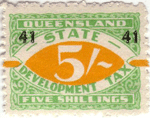
Fig 5
Development Tax Dated 1941
Tax Instalment Stamps: [Qld printed central]. In 1941 30 values 1d to £5 were printed with 15 only unique die proofs of the frame colours known. Also known with part ‘CANCELLED’ showing one of these groups of letters CAN-CEL-LED. These are from printers booklets sent to interstate tax offices as reference copies, all are very rare. All issued stamps are available with mint being rare only a handful of the £5 [fig 6] exist and would be a plus if shown. Usage is particularly rare with the £5 very rare.

Fig 6
£5 Tax Instalment
Agricultural & Pastoral Taxes.
Producers Association: In 1924 a series of stamps from 1d-£20 [fig 7] was issued excluding a £10 value, all are rare to very rare, plate proofs exist overprinted cancelled, genuine usage is very rare, the judges should appreciate any showing of these, particularly values above 1/-. Usage is rare.
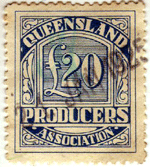
Fig 7
The Unique £20 used in 1925
Buffalo Fly Control: Plate proofs 1d-£5 were printed from 29 November 1941 all are available and should be shown. Issued stamps and usage are available with only the £5 [fig 8] being scarce to rare. Some values have security back prints to £1 print running up or down: the higher values are scarce.
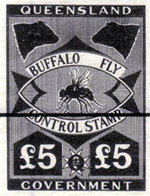
Fig 8
Buffalo Fly £5
Commodity Levies: Eight levies were issued by the COD [Committee Of Direction of Fruit Marketing]. Avocado, Banana [fig 9], Bean, Citrus, Pawpaw [fig 9], Pineapple, Tomato & Vegetable. The exhibitor must show a good selection of plate proofs along with the issued stamps both perf & rouletted all are scarce to very rare. Usage is rare.
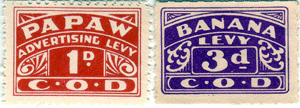
Fig 9
Pawpaw [spelt Papaw] perforated, Banana roulette
Swine Compensation: Plate proofs 1d-£5 were printed 17 April 1962 they are available and should be shown. Issued stamps [fig 10] above 2/6 appear scarce to rare, usage is hard and if shown should be appreciated. This was a very short lived issue.
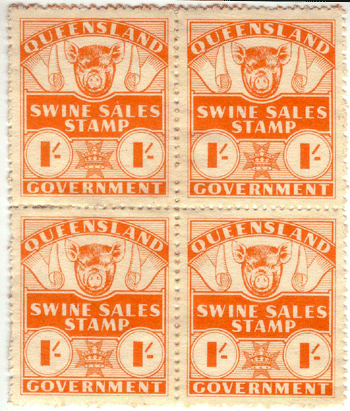
Fig 10
Swine Sales mint multiple
Harbor Dues: A ‘status unknown’ Harbour Dues [fig 11]. Imperf die & plate proofs exist in several colours. The only research to date is the name Harbor which was changed to Harbour in 1877 so we at least know this essay was prepared prior to that. Good page filler that should not be penalised if shown.
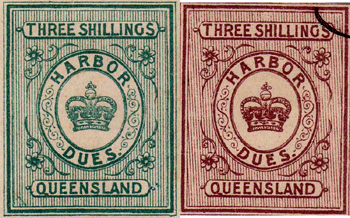
Fig 11
Pre 1877 spelling, Harbor Dues
Revenue Stamped Paper.
Postal Notes: May be included provided the exhibitor treats them as revenue stamped paper. QV 2nd series are rare. Edward [fig 12] has a unique single note recorded.
There has been recent approval [2003] by the FIP Revenue Commission regarding Postal Notes. Judges must understand this ruling fully. [see judging postal notes on the home page of this web site]. A revenue exhibit must not be penalized for postal note inclusion. If you need further information regarding postal notes please see my monograph: ‘Queensland Postal Notes’ 2004. Due to the fact there is a critical shortage of revenue judges, traditional judges tend to make the ‘team’ up. At a recent showing of a one frame postal note exhibit, written up as revenue stamped paper, three traditional judges did the judging and when asked at the frame under what Exhibition Class it was judged, one said “Stationery” and the other two said “Postal History”. When this was queried the reply was “Because postal notes are not revenues”. Please keep up with new information and do your homework.
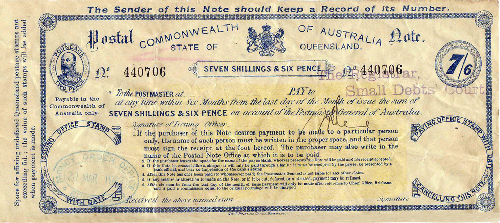
Fig 12
Postal Note
Golden Casket Tax: In 1923 Golden Casket tickets [a state lottery] had to display the portion of tax which was being collected per ticket the only known value is 3d, cut outs are known. A unique full ticket is known [fig 13]. This rule was rescinded 18 mts later.
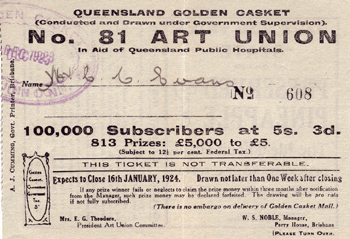
Fig 13
Golden Casket Ticket 3d Tax lower left
Betting Tax: On 6 May 1937 two values were prepared and printed 1d, 3d with the 1/- added at a later unknown date, two different size dies were used and should be explained. Forgeries abound and on 2 September 1938 a second series of tickets was issued with a changed design 1d & 3d only recorded to prevent fraud, both issues surface occasionally but appear scarce, the 1/- [fig 14] is rare.
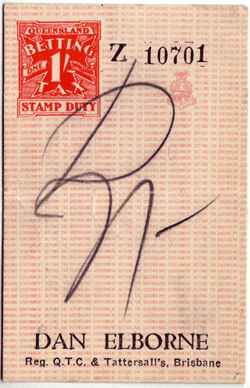
Fig 14
Betting Tax Rare 1/-
Bridge Toll Tax: Only two bridges in Queensland were Government owned and run. The rest were franchised out. Toll tax [fig 15] was levied on these two government projects the Logan River Bridge and the Story Bridge. Both built by the Main Roads Commission. The Logan Toll Bridge opened for traffic at midnight on 30 June 1931. The Story Bridge opening in 1940 & is the better known of the two Bridges. Toll tax is a grey area but never the less a government tax issued as revenue stamped paper, if shown these should not be penalized, on the contrary if a selection is shown the judge should appreciate and reward. All are rare to very rare.
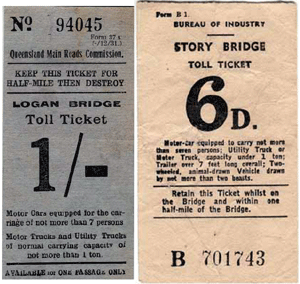
Fig 15
Logan & Story Bridge Toll Tax
In all, does the exhibitor have good understanding and knowledge of the subject? and does the exhibitor demonstrate this knowledge?.
Revenues as a relatively new class lacks published information and simple sources for obtaining material. Thus original research and the problem of acquisition of unusual material is more difficult than in more traditional classes. This should be appreciated by the judges.
Write critiques to help the exhibitor further his exhibit. Straight negative critiques are unhelpful at the best of time.
I would strongly recommend to all revenue judges to reread the FIP GREX and SREV’s before attempting to evaluate a revenue exhibit and adhere to them. Exhibitors tend to increase the size of their exhibit over a period of time as material is sourced and added to frame by frame. If an exhibit has been rewritten, do not evaluate the exhibit on past showings. Evaluate the exhibit on what you see in the frames before you.
Treatment is left to the judge’s expertise with the exhibitor following the FIP SREV’s which can be found at the FIP web site here: https://www.f-i-p.ch/ The writer can be contacted at this email address:Dave
© copyright 1997 on
All Graphics. Dave Elsmore
No part of this page may be copied used, saved in electronic form or hard printed.